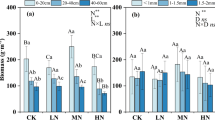Abstract
The effect of various Mg-fertilizers (MgSO4; calcined dolomite) on root growth and mineral composition of 40 yr old Norway spruce at different sites and stages of decline was studied. Two years after fertilization, density of living fine roots of Mg-deficient trees had significantly increased on fertilized compared to non-fertilized plots. Only fertilization of calcined dolomite appeared to induce new root formation in the upper mineral soil. No such changes were observed for healthy looking trees at a second experimental site, where base saturation of the bulk soil was also low but trees were sufficiently supplied with Mg. At the third experimental site where foliar analyses reflected a luxurious Ca and Mg but an insufficient K nutrition at high Mg and Ca saturation of the bulk soil, calcined dolomite caused an increase of root growth due to a reinforced antagonism between Ca and Mg competing with K uptake. In general, at the experimental sites the fine root necromass decreased when base saturation of the bulk soil increased. The elemental contents of fine roots from the minenal soil of all three sites under investigation indicated that fine root growth in the mineral soil is strongly related to the root Ca and Mg contents. Root Ca contents seemed to be mainly a function of the Ca availability in the soil. Since there was no close relationship between fine root growth and the Ca/Al molar ratio in living fine roots, Al toxicity may not completely account for the differences in root growth and nutrition on the experimental sites.
Similar content being viewed by others
References
Kaupenjohann, M.: 1989, Chemischer Bodenzustand und Nährelementversorgung immissionsbelasteter Fichtenbestände in NO-Bayern. Bayreuther Bodenkundl. Ber. 11, 1–202.
Kaupenjohann, M., Zech, W., Hantschel, R. and Horn, R.: 1987,Forstw. Cbl. 106, 78.
Murach, D.: 1984, Die Reaktion der Feinwurzeln von Fichten (Picea abies Karst.) auf zunehmende Bodenversauerung. Göttinger Bodenkundl. Ber., 77, 126 pp.
Schneider, B.U.: 1990, Feinwurzelwachstum und -ernährung immissions-belasteter Fichten- und Buchenbestände in NO-Bayern. Bayreuther Bodenkundl. Ber. 13 (in Vorb.).
Schramel, P., Klose, R.-J. and Hasse, S.: 1982,Fresenius Z. Anal. Chem. 310, 209.
Zech, W., Suttner, Th. and Popp, E.: 1985,Water, Air, and Soil Pollut. 25, 175.
Author information
Authors and Affiliations
Rights and permissions
About this article
Cite this article
Schneider, B.U., Zech, W. The influence of Mg fertilization on growth and mineral contents of fine roots in (Picea abies [Karst] L.) stands at different stages of decline in NE-Bavaria. Water Air Soil Pollut 54, 469–476 (1990). https://doi.org/10.1007/BF02385239
Issue Date:
DOI: https://doi.org/10.1007/BF02385239




